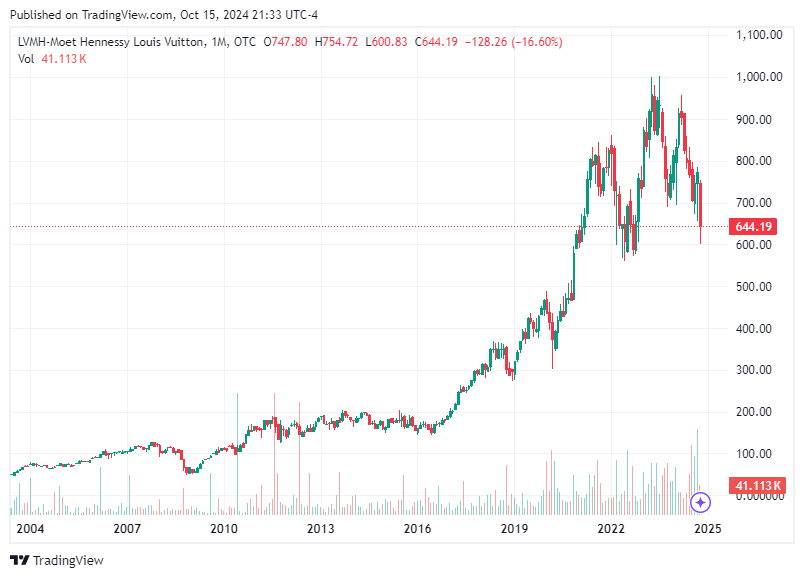Louis Vuitton Revenue Declines: Slower Japanese Growth
LVMH's Recent Revenue Decline: Navigating Challenges in Japan and Beyond.

Disclaimer: The following article is for informational purposes only and does not constitute financial advice. Readers are encouraged to conduct their own research or consult a financial advisor for personalized guidance.
LVMH Moët Hennessy Louis Vuitton, a beacon in the luxury goods industry, recently reported a revenue decline that has caught the attention of investors and market analysts worldwide. This report highlights the intricate dynamics at play within the luxury sector, particularly focusing on the challenges and market conditions in key regions such as Japan and China. As the world's largest luxury conglomerate, LVMH's performance is often seen as a barometer for the sector, making this decline an issue of broader consequence.
Financial Performance Overview
In the third quarter of 2024, LVMH reported a 3% fall in sales, marking its first quarterly decline since the pandemic era. Revenue for the quarter stood at 19.08 billion euros ($20.8 billion), falling short of the consensus estimate of 2% organic growth. This performance has been attributed largely to a slowdown in demand from crucial markets such as China and Japan.
The company's fashion and leather goods division, which includes iconic brands like Louis Vuitton and Dior, saw a 5% decline in sales. This segment alone constitutes nearly half of LVMH's revenue and a large portion of its profit, making its underperformance particularly impactful. Analysts had projected a 4% growth, highlighting the gap between expectations and reality. The failure to meet sales expectations has understandably resulted in investor trepidation. Market experts suggest that the underperformance has introduced volatility in luxury stocks. Luca Solca, an analyst at Bernstein, described the results as "misses across the board." This sentiment reveals the broader apprehension regarding the luxury sector, which has seen fluctuating fortunes amid recovering global economies.
Flavio Cereda from GAM's Luxury Brands investment strategy emphasized that LVMH's results could lead to short-term volatility in the luxury market. As a sector proxy, LVMH's performance often influences perceptions and strategies across the industry. The results have thus been a wake-up call, prompting stakeholders to reassess their expectations and approaches.
Challenges in Key Markets: Japan and China
Japan and China have been focal points in LVMH's recent performance narrative. In Japan, growth slowed considerably to 20% from a robust 57% in the previous quarter. This slowdown has been partially attributed to a stronger yen, which has reduced the purchasing power of foreign tourists—a crucial consumer segment in the Japanese luxury market.
In China, the situation is more complex. The region has experienced a slump in consumer confidence, exacerbated by ongoing property market issues. Although there were initial hopes that government stimulus measures would revitalize consumer spending, these have yet to materialize into substantial market recovery. The fashion and leather goods division's sales in Asia, excluding Japan, saw a 16% decline, further illustrating the challenges in this region. Despite these challenges, LVMH remains committed to its vision centered around craftsmanship and quality. The company's CFO, Jean-Jacques Guiony, has reiterated the importance of cost management and maintaining the company's core values of innovation and excellence. This steadfast approach is part of LVMH's long-standing method to navigate market fluctuations while preparing for future opportunities.
One area of potential growth highlighted by LVMH is the U.S. market, where there has been a slight improvement in categories like cognac, Tiffany, and fashion. This cautious optimism is based on a gradual normalization of market conditions and a less significant impact from aspirational spending, indicating a potential area for revenue stabilization.
Divisional Performance and Broader Effects
The revenue decline was not uniform across all divisions. While fashion and leather goods experienced considerable setbacks, other segments like selective retailing saw modest growth. Watches and jewelry, however, reported a 5% drop in sales, reflecting broader economic pressures.
LVMH's efforts to bolster its brand visibility through initiatives like sponsoring the Paris 2024 Olympics highlight its commitment to long-term brand equity. Events like these are viewed as short-term investments that reinforce LVMH's 'Made in France' narrative, crucial for sustaining its luxury image. The company is also investing in nurturing artisan skills through projects like the Maison des Métiers d’Excellence. This initiative reflects LVMH's recognition of the indispensable role of craftsmanship in maintaining its luxury stature. Scheduled to open in 2026, this hub aims to showcase and preserve the skills that underpin the luxury industry.
LVMH's recent financial performance presents the complexities of operating in the luxury sector amid global economic uncertainties. The company's challenges in Japan and China reflect broader market dynamics that luxury brands must navigate. Despite the current headwinds, LVMH's commitment to its core values and long-term vision positions it to weather these challenges while exploring new growth avenues.
The luxury giant's ability to adapt to changing market conditions while maintaining its commitment to quality and innovation will be crucial in determining its future trajectory. As LVMH continues to invest in its brands and artisans, it remains a pivotal player in shaping the luxury sector's future.
Disclaimer: This article is intended for informational purposes only and should not be construed as financial advice. Readers should consult financial professionals for advice tailored to their own circumstances.
We are working endlessly to provide free insights on the stock market every day, and greatly appreciate those who are paid members supporting the development of the Stock Region mobile application. Stock Region offers daily stock and option signals, watchlists, earnings reports, technical and fundamental analysis reports, virtual meetings, learning opportunities, analyst upgrades and downgrades, catalyst reports, in-person events, and access to our private network of investors for paid members as an addition to being an early investor in Stock Region. We recommend all readers to urgently activate their membership before reaching full member capacity (500) to be eligible for the upcoming revenue distribution program. Memberships now available at https://stockregion.net


